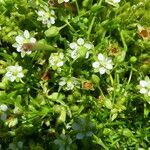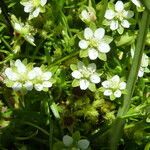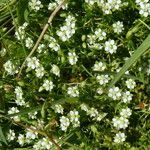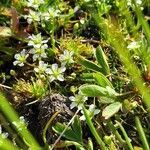Perennial polymorphous herb forming ± dense, 2-10 cm high mats or tufts. Stems erect or procumbent, rooting at the base, glabrous or glandular hairy in upper part. Leaves glabrous, linear-narrowly elliptic, mucronate, joined at the base, median nerve strongly marked on underside. Flowers usually solitary in the leaf axils, rarely two together; pedicel filiform, glabrous or glandular pubescent, up to 3 times longer than the corresponding internode, up to 25 mm in fruit, first erect, after anthesis curved downwards, later in the fruiting stage again erect. Sepals (4 or) 5, ovate-oblong, c. 3 mm long, glabrous or ± glandular pubescent, obtuse, with narrow scarious margin. Petals (4 or) 5, ovoid, obtuse, as long as or shorter than the sepals, rarely absent. Stamens 10, rarely fewer, as long as the petals. Ovary ovoid, glabrous. Capsule ± cylindrical to ovoid, about twice as long as the persistent calyx, opening to the base by (4 or) 5 valves. Seeds ± deltoid, 0.3-0.5 mm diameter, pale brown, finely verrucose or glabrous.
Herbs perennial. Stems caespitose, ca. 7 cm tall, glabrous. Leaves linear or subulate, 5--15 × ca. 1 mm, glabrous. Flower solitary, terminal. Pedicel recurved after anthesis, erect in fruit, (0.6--)1.5--3 cm. Sepals 5, ovate-oblong, 1.5--3 × ca. 1.5 mm, apex obtuse. Petals 5, ovate, shorter than sepals. Stamens (5 or)10. Styles 5. Capsule conical-ovoid, 3--5 mm, ca. 2 × as long as appressed sepals, shiny, 5-valved. Seeds brown, reniform-triangular, ca. 0.3 mm, grooved, ?sharply tuberculate. Fl. May--Jul, fr. Jul--Aug. 2n = 22.




